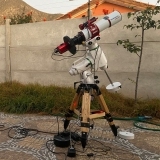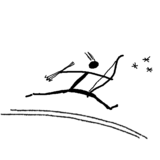INDI Library v2.0.7 is Released (01 Apr 2024)
Bi-monthly release with minor bug fixes and improvements
What means always for resetting guiding calibration
- Peter Sütterlin
-

- Offline
- Supernova Explorer
-

- Posts: 1009
- Thank you received: 133
Replied by Peter Sütterlin on topic What means always for resetting guiding calibration
Also, what about people with a mount that doesn't report pier side? How do you detect a flip there?
Please Log in or Create an account to join the conversation.
- Chris Rowland
-

- Offline
- Platinum Member
-

- Posts: 554
- Thank you received: 138
Replied by Chris Rowland on topic What means always for resetting guiding calibration
I'm not sure how PHD handles a pier side change on a mount driver that doesn't report the pier side. The way I'd resolve that is get a driver that does report the pier side, even if I had to write it myself. Reading the PHD help could give an answer, there are a number of ways that they could implement this. At worst redoing the calibration after every slew.
Dither is handled by the guide application offseting the guide star position and using the normal guide commands to drive the guide star to the new position. My guide system has a pixel size of 1.68 arc seconds so a 2 pixel dither will need a little under 0.5 seconds of guiding at 50% rate. For PHD Ekos will send a dither command at a time of it's choosing and will then wait until it's guide accuracy criteria have been reached.
Please Log in or Create an account to join the conversation.
- Peter Sütterlin
-

- Offline
- Supernova Explorer
-

- Posts: 1009
- Thank you received: 133
Replied by Peter Sütterlin on topic What means always for resetting guiding calibration
Please Log in or Create an account to join the conversation.
Replied by alacant on topic What means always for resetting guiding calibration
I think it important that whatever change which is made to the EKOS guider, leaves the PHD2 behaviour exactly as it is.
Thanks.
Please Log in or Create an account to join the conversation.
- Wouter van Reeven
-

- Offline
- Supernova Explorer
-

- Posts: 1957
- Thank you received: 420
Replied by Wouter van Reeven on topic What means always for resetting guiding calibration
If this means that current users need to modify their configuration to maintain the current behaviour then that should be documented and announced to all users.
Wouter
Please Log in or Create an account to join the conversation.
- Jose Corazon
-

- Offline
- Supernova Explorer
-

- Posts: 1119
- Thank you received: 182
Replied by Jose Corazon on topic What means always for resetting guiding calibration
The mount may not send that signal, but wouldn't Ekos detect that it is sending commands to the mount to move across the meridian and that recalibration or calibration swap is required?
At least during the imaging of the first scheduled target that works, but when the second target it initiated, calibration does not seem to get swapped back. Ekos definitely has that information, since it accurately calculates the time until the next meridian flip.
Please Log in or Create an account to join the conversation.
- Peter Sütterlin
-

- Offline
- Supernova Explorer
-

- Posts: 1009
- Thank you received: 133
Replied by Peter Sütterlin on topic What means always for resetting guiding calibration
Yes, that it does know. But it has no way of checking if that switch had actually taken place. Only the mount knows which side it is on, not based on coordinates, but based on the steps/position of the motors.
Usually you can give a good guess which side you're on (like, when the position is more than 10-15 degrees away from the meridian). But inbetween always both pointings would be possible, and where you are depends on the history.
Please Log in or Create an account to join the conversation.
- Chris Rowland
-

- Offline
- Platinum Member
-

- Posts: 554
- Thank you received: 138
Replied by Chris Rowland on topic What means always for resetting guiding calibration
Maybe the mount has functions to read the axis positions, if that's the case then the driver can deterine the pier side.
All this only applies to GEMs a fork mount usually stays in the same pointing state everywhere.
Please Log in or Create an account to join the conversation.
- Wolfgang Reissenberger
-
 Topic Author
Topic Author
- Offline
- Moderator
-

- Posts: 1187
- Thank you received: 370
Replied by Wolfgang Reissenberger on topic What means always for resetting guiding calibration
@alakant: this change applies to all guiders. If the option "Always Reset Guide Calibration" is selected, both internal and external guiders receive a "clear calibration" command for each slew detected. If the option is NOT set, all decisions about calibration are left to the selected guider.
Regarding mounts that do not report the pier side, I cannot answer it, since my mounts and the simulator support it. Needs to be tested, but worst case simply set the option.
HTH
-- Wolfgang
Please Log in or Create an account to join the conversation.
Replied by Andrew on topic What means always for resetting guiding calibration
Narrowing the trigger criteria may help, such as if slews in Dec are substantial, as RA only impacts calibration when pier-side changes. But IMHO implementing declination compensation with recalibrations only after pier-side change and guiding failure is ideal.
Food for thought. Thank you
- Andrew.
Please Log in or Create an account to join the conversation.
- Wouter van Reeven
-

- Offline
- Supernova Explorer
-

- Posts: 1957
- Thank you received: 420
Replied by Wouter van Reeven on topic What means always for resetting guiding calibration
Please Log in or Create an account to join the conversation.
- Jose Corazon
-

- Offline
- Supernova Explorer
-

- Posts: 1119
- Thank you received: 182
Replied by Jose Corazon on topic What means always for resetting guiding calibration
Hi Andrew:
The original reason for the recalibration after slewing is that some mounts, such as the iOptron mounts, do not recognize when they are slewing across the meridian. Which means that when using the scheduler, the second sequence is ruined as the previous calibration swap is not reversed. The only way to fix that is to recalibrate.
Not elegant, perhaps. But the problem in that case is with iOptron and other mount manufacturers that cannot get their firmware act together, not with Ekos. If there is another more elegant workaround to solve the problem, please let us know.
Jo
Please Log in or Create an account to join the conversation.
